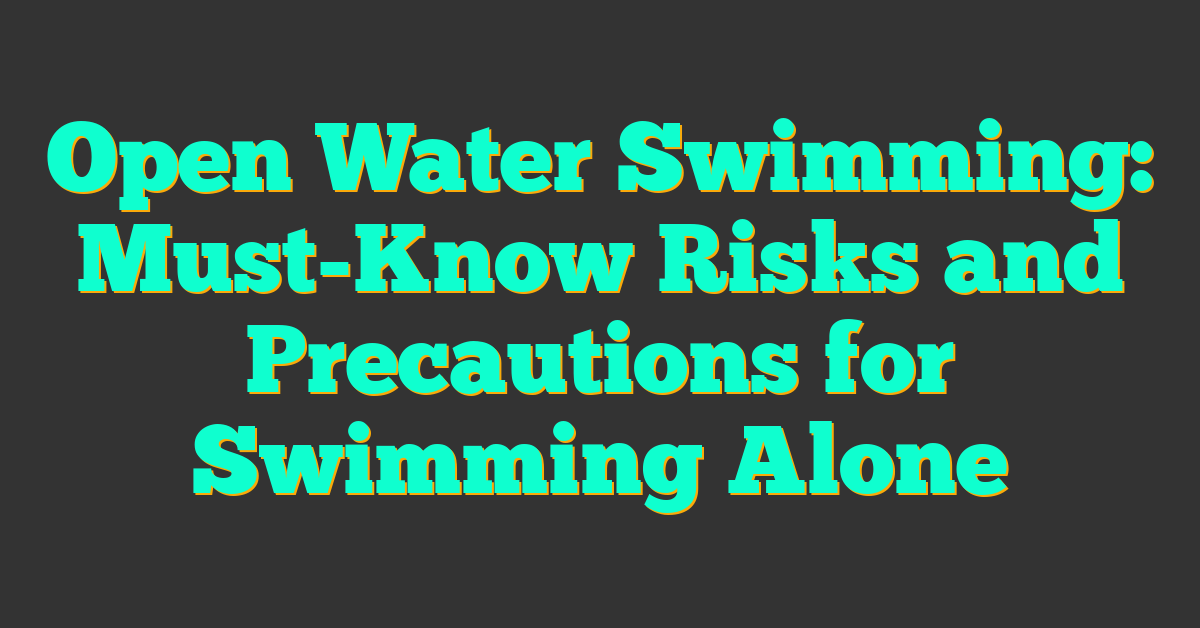Swimming is a popular activity that can provide numerous health benefits, but it also involves certain risks. Open water swimming, in particular, can be dangerous if you swim alone. While swimming alone in a pool can also be risky, open water swimming presents additional hazards that you need to be aware of.

If you are considering open water swimming, it is important to understand the risks involved. Open water swimming can be unpredictable, and the conditions can change rapidly. You may encounter strong currents, waves, and other hazards that can put your safety at risk. In addition, if you are swimming alone, there is no one to help you in case of an emergency.
To minimize the risks of open water swimming, it is important to take certain safety precautions. This may include wearing a wetsuit, using a swim buoy, and swimming in designated areas. It is also important to let someone know where you are going and when you plan to return. By taking these precautions, you can enjoy the benefits of open water swimming while minimizing the risks.
Key Takeaways
- Open water swimming can be dangerous if you swim alone due to the unpredictable conditions and lack of assistance in case of emergency.
- To minimize the risks of open water swimming, take safety precautions such as wearing a wetsuit, using a swim buoy, and swimming in designated areas.
- Let someone know where you are going and when you plan to return to ensure your safety.
Understanding the Risks of Swimming Alone
https://www.youtube.com/watch?v=kZ2cTaU2uOw&embed=true

Swimming alone in open water can be dangerous and it is important to understand the risks involved. Here are some of the hazards you need to be aware of:
Drowning Hazards
Drowning is the leading cause of unintentional injury death worldwide, and swimming alone increases the risk of drowning. Even experienced swimmers can get into trouble if they are swimming alone. It is important to be aware of your own swimming ability and to never overestimate your capabilities. Always swim within your limits and avoid swimming in areas with strong currents or tides.
Weather and Water Conditions
Weather and water conditions can change rapidly and can pose a significant risk to swimmers. It is important to check the weather forecast and water conditions before swimming, and to avoid swimming during storms or in rough water. Rip currents are also a hazard that swimmers need to be aware of. If you are caught in a rip current, swim parallel to the shore until you are out of the current, and then swim back to shore.
Marine Life and Natural Hazards
Swimming in open water exposes you to marine life and natural hazards. These can include jellyfish, sharks, and other dangerous animals. It is important to be aware of the marine life in the area you are swimming in, and to avoid swimming in areas where dangerous animals are known to be present. In addition, open water can contain bacteria and other harmful microorganisms that can cause infection. Always check the water quality before swimming and avoid swimming in areas with poor water quality.
By understanding the risks involved in swimming alone in open water, you can take steps to minimize those risks and enjoy a safe and enjoyable swimming experience. Remember to always swim with a buddy, check the weather and water conditions, and be aware of the marine life and natural hazards in the area you are swimming in.
Safety Precautions for Open Water Swimmers
https://www.youtube.com/watch?v=zV4z0M-sZ_A&embed=true
When it comes to open water swimming, safety should always be your top priority. Here are some safety precautions you should take before hitting the water:
Proper Equipment
Having the right equipment can make all the difference in open water swimming. A wetsuit can help keep you warm and buoyant, while a buoy or tow float can help you stay visible and provide extra buoyancy. It is also recommended to wear a life jacket or personal flotation device (PFD) if you are not a strong swimmer. Additionally, don’t forget to apply sunscreen to protect your skin from harmful UV rays.
Swimming Techniques and Tips
Proper swimming techniques can help you conserve energy and swim more efficiently. It is important to breathe rhythmically and avoid hyperventilating, as this can lead to fatigue and cramping. Also, make sure to swim parallel to the shore and never swim too far from a safe exit point. Always be aware of your surroundings, including boats and other watercraft.
Emergency Preparedness
No matter how prepared you are, emergencies can still happen. Always bring a whistle with you in case you need to signal for help. It is also a good idea to let someone know where you are swimming and when you plan to return. If you are swimming alone, consider using a GPS tracking device so that others can locate you in case of an emergency.
Remember, safety should always be your top priority when swimming in open water. By following these safety precautions and tips, you can help ensure a safe and enjoyable swim.
Health and Wellbeing Considerations
https://www.youtube.com/watch?v=z7h-l7dCOa0&embed=true
As an open water swimmer, it is important to consider both your physical fitness and mental health when deciding to swim alone. Here are some factors to keep in mind to ensure your safety and wellbeing.
Physical Fitness and Conditions
Before swimming alone in open water, make sure you are physically fit enough to handle the swim. If you have any pre-existing medical conditions, such as heart problems or asthma, consult with your doctor before swimming. Additionally, make sure you are well-rested and hydrated before swimming to prevent cramps and fatigue.
Mental Health Factors
Swimming alone in open water can be a relaxing and meditative experience, but it can also be anxiety-inducing. It is important to be aware of your mental state before swimming alone. If you are feeling depressed or anxious, it may be best to swim with a partner or not swim at all. However, if you are in a positive mood and feel comfortable swimming alone, take the necessary precautions to ensure your safety.
Remember, open water swimming has many health benefits, but it also comes with risks such as cold water shock and hypothermia. By considering your physical fitness and mental health, you can enjoy the benefits of open water swimming while minimizing the risks.
Planning and Preparing for Open-Water Swimming

When it comes to open-water swimming, planning and preparation are crucial to ensure your safety. Here are some important things to consider before you hit the water.
Choosing the Right Location
« How to Avoid Flat Tires in Triathlons: Causes and Prevention Tips
How Do Swimmers Know When to Turn and Stop? »
Choosing the right location for open-water swimming is key. Look for a location that is well-prepared for swimmers, such as a swimming pool or a designated swimming area in a lake or ocean. Swimming in unprepared areas can be dangerous due to the unpredictable nature of nature. In addition, make sure the location is suitable for your swimming ability level and that you are familiar with the area.
Understanding Local Regulations and Guidelines
It is important to understand local regulations and guidelines before you start your open-water swimming expedition. Regulations and guidelines can vary depending on the location, so make sure to research the area beforehand. In the UK and US, for example, many beaches have lifeguards on duty during peak swimming season. Make sure to follow their instructions and pay attention to warning signs.
It is also important to understand the buoyancy and shoreline of the location you choose. Make sure to identify an exit point before you start swimming and to stay close to the shore. Always swim within your ability level and never swim alone. If possible, swim with a buddy, and make sure to notify someone on shore of your swimming plans and expected return time.
By taking these precautions and preparing properly, you can help ensure a safe and enjoyable open-water swimming experience.
The Benefits of Not Swimming Alone

Swimming alone can be tempting, but it is not worth the risk. By having a swimming buddy, you can enjoy a safer and more enjoyable swimming experience. Here are some benefits of not swimming alone:
Safety
Swimming with a buddy is the safest way to swim. Your buddy can keep an eye on you and make sure you are okay. If you start to struggle, your buddy can help you and call for help if needed. Also, if you both swim near boats or kayaks, it is easier for them to see you both and avoid accidents.
Drafting
Drafting is when you swim behind someone to reduce the resistance of the water. This can help you swim faster and conserve energy. If you have a swimming buddy, you can take turns drafting each other to make your swim more efficient.
Natural Bodies of Water
Swimming in natural bodies of water can be unpredictable. There may be strong currents, waves, or underwater obstructions that you may not be aware of. Having a swimming buddy can help you navigate these challenges and stay safe.
Young Children
If you have young children, it is especially important to have a swimming buddy. Children can quickly get into trouble in the water, and having an extra set of eyes can help prevent accidents.
In conclusion, swimming with a buddy is essential for safe swimming. Whether you are swimming in a pool or open water, having a buddy can make your swim more enjoyable and safer.
Frequently Asked Questions

What precautions should I take when swimming alone in open water?
When swimming alone in open water, it is important to take certain precautions to ensure your safety. First, always let someone know where you are going and when you plan to return. Second, never swim alone in unfamiliar or hazardous conditions. Third, be aware of your own swimming abilities and limitations, and avoid pushing yourself too hard. Finally, always wear a brightly colored swim cap and use a swim buoy or other flotation device to increase your visibility to other boaters and swimmers.
What are the common risks associated with open water swimming?
Open water swimming presents a number of risks that are not present in a pool or other controlled environment. These risks include strong currents, waves, cold water, and marine life such as jellyfish or sharks. Additionally, open water swimmers are at risk of becoming disoriented or lost, especially in low visibility conditions such as fog or darkness.
How can I stay safe while swimming in the ocean at night?
Swimming in the ocean at night is not recommended, as it is difficult to see and be seen by other swimmers or boaters. If you must swim in the ocean at night, be sure to wear a brightly colored swim cap and use a waterproof headlamp to increase your visibility. Additionally, stay close to shore and avoid swimming in areas where boats are likely to be present.
Why is swimming in rivers considered dangerous?
Swimming in rivers can be dangerous due to the strong currents and unpredictable water conditions. River currents can be deceptively strong, and even experienced swimmers can be swept away by the force of the water. Additionally, rivers may contain hidden obstacles such as rocks or logs that can pose a danger to swimmers.
What emergency flotation devices are recommended for open water swimmers?
Open water swimmers should always carry a flotation device such as a swim buoy or life jacket in case of emergency. Swim buoys are lightweight and easy to tow behind you while swimming, and can provide a visible marker for other boaters and swimmers. Life jackets are more buoyant and can provide additional protection in rough water or cold conditions.
What strategies can open water swimmers use to stay safe?
Open water swimmers can take a number of steps to stay safe while swimming. First, always swim with a buddy or in a group, especially in unfamiliar or hazardous conditions. Second, be aware of your own swimming abilities and limitations, and avoid pushing yourself too hard. Third, wear a brightly colored swim cap and use a swim buoy or other flotation device to increase your visibility to other boaters and swimmers. Finally, always be aware of your surroundings and be prepared to exit the water quickly if necessary.










